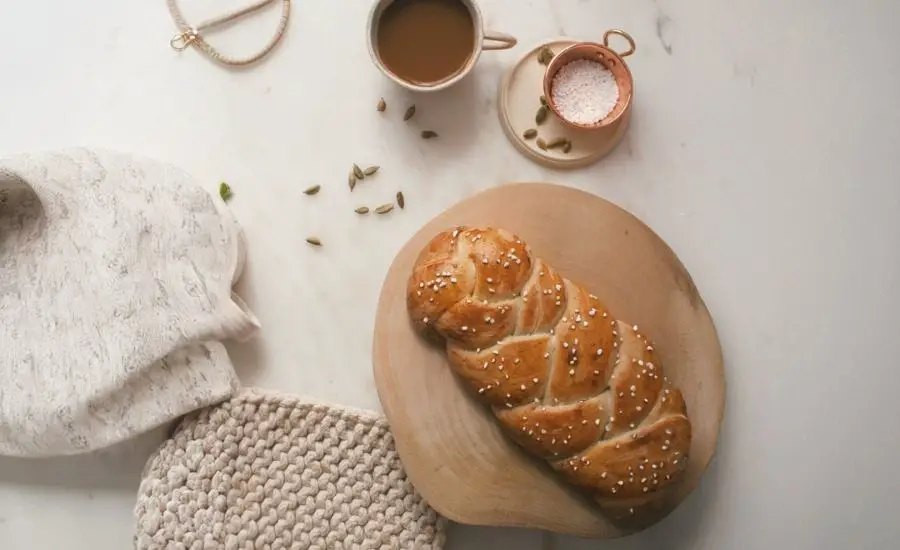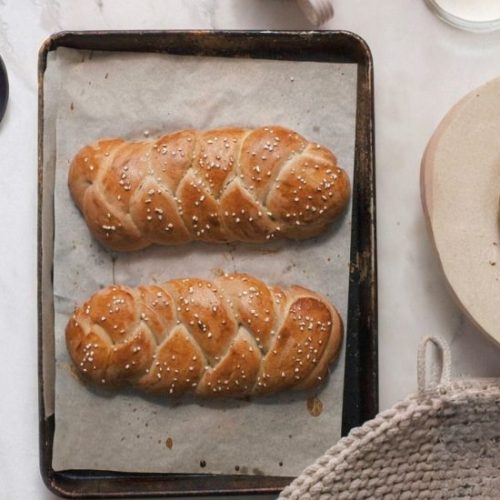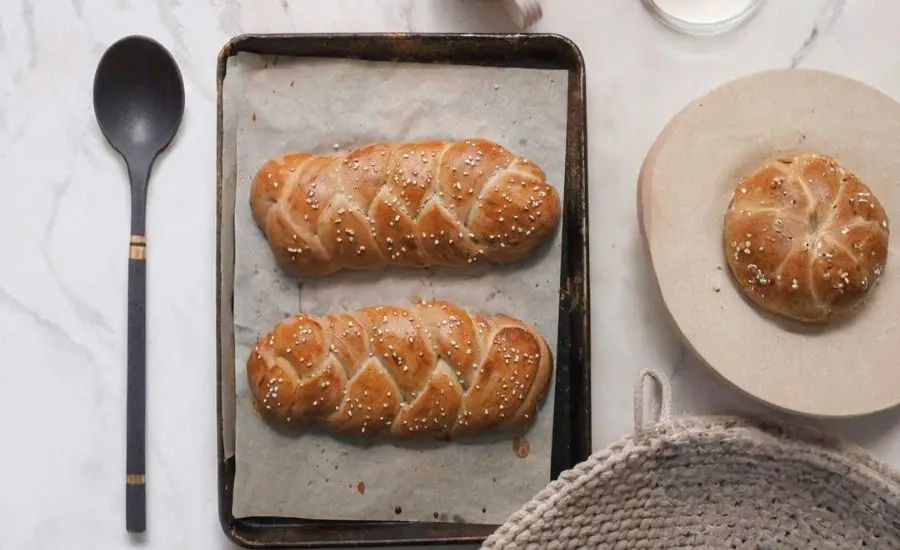All products are selected by our editorial team for quality. If you buy through our links, we may earn a small commission at no extra cost to you.
This Swedish Braided Cardamom Bread is a charming and fragrant treat that brings a touch of Scandinavian tradition right to your kitchen.
Its enriched dough, subtly spiced with aromatic cardamom, delivers a comforting warmth perfect for cozy mornings or holiday gatherings.
While this bread is a delightful indulgence, it also contains beneficial ingredients like whole milk and eggs that provide quality protein and essential fats to support satiety and energy.
The inclusion of cardamom adds antioxidant properties and aids digestion, making each bite as nourishing as it is flavorful.
Despite requiring a bit of rising time, this recipe is straightforward and approachable, making it an excellent choice for weekend baking or meal prep to enjoy fresh homemade bread throughout the week.

Its beautiful braided shape also makes it a stunning centerpiece for any table.
Must-Have Tools for Perfect Results
KitchenAid Stand Mixer
Ideal for effortlessly mixing and kneading the enriched dough, this versatile mixer saves time and ensures consistent results, making it indispensable for any bread baker.
Saucepan
Perfect for gently warming the milk and dissolving sugar and butter, a good-quality saucepan helps maintain even heat without scorching ingredients, essential for activating yeast.
Baking Sheet with Parchment Paper
Provides a non-stick surface for baking the braided loaves evenly, and makes cleanup quick and hassle-free, useful for baking a wide variety of goods.
Pastry Brush
Essential for applying the egg wash evenly over the bread’s surface, ensuring a glossy, golden finish that enhances both appearance and texture.
Measuring Cups and Spoons
Precision in measuring ingredients like flour, sugar, and spices is crucial for perfect dough consistency and flavor balance; reliable measuring tools are kitchen staples.

Swedish Braided Cardamom Bread
Equipment
- 1 KitchenAid Stand Mixer or large mixing bowl with wooden spoon
- 1 Saucepan
- 2 Baking sheets, lined with parchment paper
- 1 Pastry brush
- Measuring cups and spoons
Ingredients
- 2 cups whole milk
- ⅔ cup granulated sugar
- ½ cup unsalted butter
- 2 packets active dry yeast or instant yeast
- 6 cups all-purpose flour divided
- ¾ teaspoon kosher salt
- 2 teaspoons ground cardamom
- 2 large eggs divided
- 1 tablespoon whole milk for egg wash
- 2 tablespoons Swedish pearl sugar
Instructions
- Prepare the Warm Milk Mixture: In a small saucepan, combine the whole milk and granulated sugar. Place the saucepan over medium-low heat and whisk gently until the sugar fully dissolves. Add the unsalted butter to the warm milk, stirring carefully until the butter has melted completely. Remove the saucepan from the heat and allow the milk mixture to cool down to a lukewarm temperature, roughly the warmth of a bath (about 100°F or 38°C). This temperature is critical; if too hot, it can kill the yeast, and if too cold, the yeast won’t activate properly.
- Activate the Yeast: Once the milk mixture has cooled to the right temperature, sprinkle the yeast evenly over the surface and gently stir it in. Let this mixture sit undisturbed for 5 minutes. During this time, the yeast will begin to foam and bubble, a sign that it is active and ready to leaven your dough. If you see little bubbles or some froth forming, you’re good to move on; if not, consider trying a new batch of yeast.
- Combine Dry Ingredients and Initial Mixing: In a large mixing bowl or the bowl of your stand mixer fitted with the dough hook, add 2 cups of the all-purpose flour along with the kosher salt and ground cardamom. Pour in the activated milk and yeast mixture, then crack in one of the large eggs. Begin mixing on low speed or stir with a wooden spoon until the ingredients come together into a loose, wet dough.
- Incorporate Remaining Flour Gradually: Add 3 more cups of flour to the dough and continue mixing until the flour is fully incorporated. The dough will start to thicken but may still feel sticky. Slowly add the remaining flour, about a quarter cup at a time, kneading after each addition until the dough forms a smooth, elastic ball that’s just slightly tacky to the touch but not overly sticky. Be careful not to add too much flour, as this can make the bread dense and dry.
- First Rise – Let the Dough Double: Lightly oil a large bowl and transfer your dough ball into it, turning it gently to coat all sides with oil. Cover the bowl tightly with plastic wrap or a clean kitchen towel and place it in a warm, draft-free spot to rise. Allow the dough to rest and double in size; this should take approximately 1 hour. The dough should look puffy and soft, signaling the yeast’s work.
- Punch Down and Knead Lightly: After the first rise, gently punch down the dough to release the trapped air. Transfer it onto a lightly floured surface and knead it gently for 1 to 2 minutes to even out the texture. Cover the dough with a clean towel and let it rest for 10 minutes to relax the gluten, making it easier to shape.
- Divide and Roll into Ropes: Cut the rested dough into six equal portions using a bench scraper or sharp knife. Roll each piece into a long, thin rope approximately 15 inches in length, maintaining even thickness throughout. This step is essential to achieve the beautiful braid structure.
- Braid the Dough: Take three ropes and place them side by side on your work surface. Pinch one end of the ropes together firmly to secure them, then gently braid them by crossing the ropes over one another in a traditional three-strand braid. Once you reach the end, pinch the ends together and tuck them slightly under the loaf to create a neat finish. Repeat this braiding process with the remaining three ropes to form the second loaf.
- Second Rise on Baking Sheets: Line two baking sheets with parchment paper and carefully transfer each braided loaf onto the sheets. Cover them loosely with a clean kitchen towel and allow the loaves to rise for 30 minutes at room temperature. During this time, the dough will puff up slightly, preparing for a tender crumb and light texture.
- Preheat the Oven and Prepare Egg Wash: While the loaves rise, preheat your oven to 375°F (190°C). In a small bowl, whisk together the remaining egg and 1 tablespoon of whole milk to create an egg wash. This mixture will give your bread a shiny, golden crust when baked.
- Apply Egg Wash and Add Topping: Once the loaves have risen, gently brush the egg wash over the entire surface of both braided breads using a pastry brush. Take care to cover all sides evenly without deflating the dough. Immediately sprinkle 1 tablespoon of Swedish pearl sugar over the top of each loaf. The pearl sugar will add a sweet crunch and attractive finish after baking.
- Bake Until Golden Brown: Place the baking sheets in the preheated oven and bake the loaves for approximately 20 minutes, or until the bread develops a deep golden brown color and sounds hollow when tapped on the bottom. Baking times may vary slightly depending on your oven, so start checking at the 18-minute mark to avoid overbaking.
- Cool Before Serving: Remove the loaves from the oven and transfer them to a wire rack to cool completely. Cooling is crucial to set the crumb structure and make slicing easier. Once cooled, slice and enjoy the warm, aromatic bread fresh or toasted with your favorite spreads.
Notes
- Use fresh, high-quality yeast for best rising results.
- Warm the milk gently; overheating can kill the yeast.
- Adjust flour quantity slightly based on dough consistency; it should be soft but not sticky.
- Let the dough rise in a warm, draft-free environment to encourage proper fermentation.
- Braiding takes practice—don’t worry if your first attempts aren’t perfect.
- Swedish pearl sugar is ideal for topping, but coarse sugar can be a substitute.
- Allow the bread to cool fully before slicing to maintain texture and avoid gummy slices.
Chef’s Secrets to Flawless Bread
The key to a perfect Swedish Braided Cardamom Bread lies in gentle temperature control and patient rising.
Ensuring your milk is lukewarm—not hot—is crucial to activate the yeast without killing it.
Using a stand mixer can save time and produce a smooth, elastic dough, but kneading by hand works too if you prefer.
When adding flour, do it gradually; over-flouring makes the bread dense rather than light and fluffy.
The braiding technique is what gives this bread its iconic look—take your time and keep the ropes even for the best presentation.
Finally, don’t rush the rising stages; allowing the dough to double in size ensures a tender crumb and rich flavor.
Serving Suggestions for Enjoyment
This aromatic cardamom bread is perfect fresh from the oven, enjoyed with a pat of butter or a smear of your favorite jam.
For a traditional Scandinavian touch, serve it alongside a hot cup of coffee or tea during breakfast or fika (Swedish coffee break).
It also pairs beautifully with cream cheese or honey for a sweet snack.
For a heartier option, try it toasted and topped with nut butters or sliced cheese.
Its subtle spice and sweetness make it versatile enough for both sweet and savory accompaniments, ideal for family gatherings or festive brunches.
Storage Tips for Freshness
To keep your braided bread fresh, store it tightly wrapped in plastic wrap or in an airtight container at room temperature for up to 3 days.
Avoid refrigeration, as this can dry out the bread and alter its texture.
For longer storage, slice and freeze the bread in a sealed freezer bag for up to 3 months.
When ready to eat, thaw slices at room temperature or warm them gently in a toaster or oven to restore softness and aroma.
Proper storage helps retain the bread’s delicate crumb and the crisp pearl sugar topping.
Frequently Asked Questions About Bread
1. Can I substitute the yeast used in this recipe?
Yes, both active dry yeast and instant yeast work well. If using instant yeast, you can mix it directly with the dry ingredients without proofing, but for active dry yeast, proofing in warm milk is recommended.
2. What if I don’t have Swedish pearl sugar?
Pearl sugar provides a crunchy, sweet topping. If unavailable, coarse sugar or crushed sugar cubes can be a good alternative, though the texture might be slightly different.
3. Can I make this bread without eggs?
Eggs add richness and help with the bread’s structure and browning. You can experiment with egg substitutes, but the texture and flavor may vary.
4. How do I know when the bread is fully baked?
The bread should be golden brown on top and sound hollow when tapped on the bottom. Internal temperature of about 190°F (88°C) also indicates doneness.
5. Can I prepare the dough in advance?
Yes, you can prepare the dough and refrigerate it overnight after the first kneading. Just allow it to come to room temperature and complete the final rising before braiding and baking.
This recipe is inspired by acozykitchen and has been carefully refined to enhance clarity, streamline preparation steps, and ensure accurate results. We’ve also included health benefits, nutritional highlights, and Must-Have Tools to help you get the best results every time you cook.


